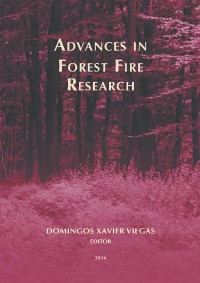Please use this identifier to cite or link to this item:
https://hdl.handle.net/10316.2/34307| DC Field | Value | Language |
|---|---|---|
| dc.contributor.author | Pinto, Renata Machado dos Santos | |
| dc.contributor.author | Sá, Ana | |
| dc.contributor.author | Benali, Akli | |
| dc.contributor.author | Pereira, José Miguel Cardoso | |
| dc.contributor.author | Fernandes, Paulo M. | |
| dc.date.accessioned | 2014-10-24T11:09:44Z | |
| dc.date.accessioned | 2020-09-09T21:31:21Z | - |
| dc.date.available | 2014-10-24T11:09:44Z | |
| dc.date.available | 2020-09-09T21:31:21Z | - |
| dc.date.issued | 2014 | - |
| dc.identifier.isbn | 978-989-26-0884-6 (PDF) | |
| dc.identifier.uri | https://hdl.handle.net/10316.2/34307 | - |
| dc.description.abstract | We explore the forecasting capability of two spatially-explicit fire spread models, HFire and FARSITE, and the potential of combining fire spread models and satellite data. A well-documented wildfire that occurred in southern Portugal in July 2012 (approx. 24800ha) is investigated. Accuracy of the fire spread models is evaluated by comparing simulated fire spread perimeters with the reported spatio-temporal distribution of the wildfire event, at three different time steps. Results show good agreement between the simulated and observed burned area perimeters (Sørensen metric). Some differences are found in specific fire propagation time intervals. When simulations are initialized using the reported ignition point, FARSITE progressively shows an underestimation of the fire’s time of arrival, whereas HFire shows an overestimation for some time steps. Initializing fire-spread simulations with active-fires ignition points improves time of arrival predictions for some time steps. FARSITE is able to predict abrupt changes in rate of spread and fire line intensity, consistent with the reported information for the wildfire event. Both models show good capability to forecast fire spread. The use of fire spread models with satellite data has great potential since the combination of both improves fire growth and behavior predictions, providing valuable supplementary information to fire management and decision support during large wildfire events. | eng |
| dc.language.iso | eng | - |
| dc.publisher | Imprensa da Universidade de Coimbra | por |
| dc.relation.ispartof | http://hdl.handle.net/10316.2/34013 | por |
| dc.rights | open access | - |
| dc.subject | HFire | eng |
| dc.subject | FARSITE | eng |
| dc.subject | fire spread modelling | eng |
| dc.subject | satellite active-fires | eng |
| dc.subject | fire suppression | eng |
| dc.subject | MODIS | eng |
| dc.subject | fire behaviour | eng |
| dc.title | Exploring the capability to forecast wildfires: spatial modelling of the Tavira/São Brás de Alportel 2012 wildfire | por |
| dc.type | bookPart | por |
| uc.publication.firstPage | 736 | - |
| uc.publication.lastPage | 748 | - |
| uc.publication.location | Coimbra | por |
| dc.identifier.doi | 10.14195/978-989-26-0884-6_82 | - |
| uc.publication.section | Chapter 3 - Fire Management | por |
| uc.publication.digCollection | PB | por |
| uc.publication.orderno | 82 | - |
| uc.publication.area | Ciências da Engenharia e Tecnologias | por |
| uc.publication.bookTitle | Advances in forest fire research | - |
| uc.publication.manifest | https://dl.uc.pt/json/iiif/10316.2/34307/211399/manifest?manifest=/json/iiif/10316.2/34307/211399/manifest | - |
| uc.publication.thumbnail | https://dl.uc.pt/retrieve/11173042 | - |
| uc.publication.parentItemId | 53868 | - |
| uc.itemId | 70289 | - |
| item.fulltext | With Fulltext | - |
| item.grantfulltext | open | - |
| Appears in Collections: | Advances in forest fire research | |
Files in This Item:
| File | Description | Size | Format | |
|---|---|---|---|---|
| 978-989-26-0884-6_82.pdf | 2.73 MB | Adobe PDF |  |
Items in DSpace are protected by copyright, with all rights reserved, unless otherwise indicated.
